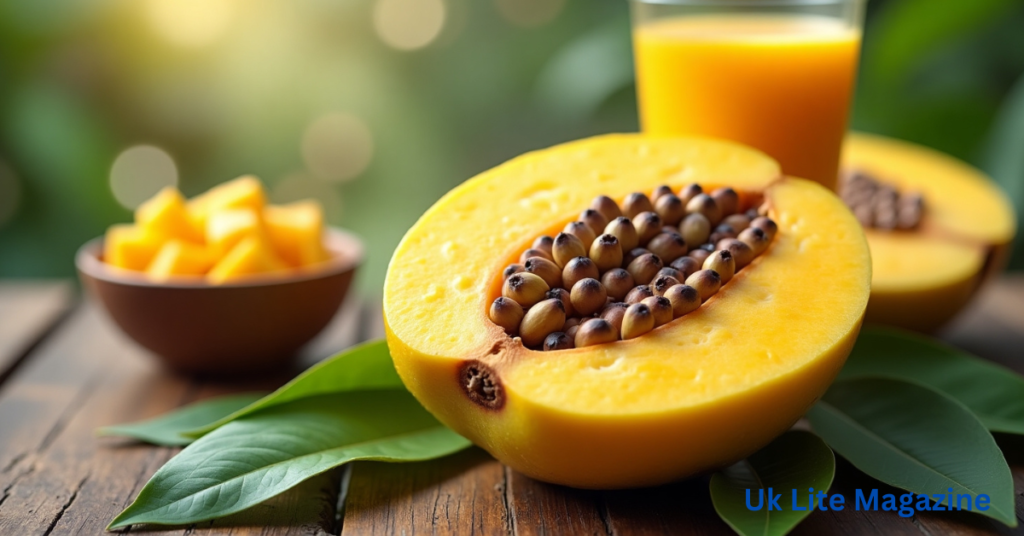Pawpaw, also known as Asimina triloba, is a nutritious fruit that is often overlooked despite its incredible health benefits. Packed with vitamins, minerals, and antioxidants, this tropical fruit offers numerous advantages for overall well-being. In this article, we will explore the key health benefits of pawpaw, its nutritional content, and how it can be included in your diet.
Nutritional Value of Pawpaw
Pawpaw is a powerhouse of essential nutrients. Below is a table summarizing its key nutritional components per 100 grams of fruit:
| Nutrient | Amount per 100g | Health Benefit |
|---|---|---|
| Calories | 80 kcal | Provides energy |
| Carbohydrates | 18g | Supports digestion & energy levels |
| Fiber | 2.6g | Aids digestion & gut health |
| Vitamin C | 20mg (22% DV) | Boosts immunity & skin health |
| Vitamin A | 950 IU (19% DV) | Supports vision & skin health |
| Potassium | 250mg | Regulates blood pressure |
| Magnesium | 21mg | Supports muscle & nerve function |
| Antioxidants | High | Protects against cell damage |
Health Benefits of Pawpaw
1. Boosts Immunity
Pawpaw is rich in Vitamin C, a powerful antioxidant that strengthens the immune system and helps the body fight infections and illnesses. Regular consumption can reduce the risk of common colds and flu.
2. Supports Digestive Health
The high fiber content in pawpaw aids digestion by promoting healthy bowel movements and preventing constipation. Additionally, enzymes like papain help break down proteins, improving nutrient absorption.
3. Promotes Healthy Skin
Pawpaw contains Vitamin A and antioxidants, which help maintain healthy skin by reducing wrinkles, improving skin texture, and preventing damage from free radicals. Applying pawpaw extracts topically can also help with acne and skin hydration.
4. Aids in Weight Management
Low in calories but rich in fiber, pawpaw helps in weight management by keeping you full for longer. It can be a great addition to a balanced diet for those looking to lose weight.
5. Improves Heart Health
Pawpaw is high in potassium and fiber, which help regulate blood pressure and reduce cholesterol levels. These nutrients contribute to a healthier heart by reducing the risk of cardiovascular diseases.
6. Enhances Eye Health
The presence of Vitamin A and lutein in pawpaw supports eye health by protecting against vision-related problems like cataracts and age-related macular degeneration.
7. Helps Reduce Inflammation
Pawpaw has natural anti-inflammatory properties, which may help relieve symptoms of arthritis and other inflammatory conditions. The antioxidants present in the fruit also protect against chronic diseases.
8. Supports Muscle and Nerve Function
The magnesium and potassium found in pawpaw help maintain proper muscle function, nerve signaling, and electrolyte balance in the body, preventing cramps and muscle fatigue.
9. Aids in Wound Healing
Pawpaw contains enzymes like papain, which have been known to aid wound healing by reducing swelling and speeding up tissue repair. It is also used in some medicinal ointments.
How to Include Pawpaw in Your Diet
You can enjoy pawpaw in various ways, such as:
- Eating it fresh as a snack
- Adding it to smoothies for a tropical twist
- Using it in fruit salads for added flavor and nutrition
- Blending it into juices for a refreshing drink
- Incorporating it into desserts like puddings and ice creams
Conclusion
Pawpaw is a highly nutritious fruit that provides numerous health benefits, from boosting immunity to promoting heart health. Its rich vitamin and antioxidant content make it a valuable addition to a healthy diet. Whether eaten fresh or used in various recipes, pawpaw is a delicious and beneficial fruit that deserves more recognition.
Frequently Asked Questions (FAQs)
1. Is pawpaw the same as papaya?
No, pawpaw and papaya are different fruits. Pawpaw belongs to the Asimina family and is native to North America, while papaya belongs to the Caricaceae family and is commonly found in tropical regions.
2. Can pawpaw seeds be eaten?
Yes, but in small amounts. Pawpaw seeds contain compounds that may have medicinal properties, but excessive consumption can be toxic.
3. How do I know when a pawpaw is ripe?
A ripe pawpaw is soft to the touch and has a sweet aroma. Its skin may turn yellow or brownish, indicating it is ready to eat.
4. Are there any side effects of eating pawpaw?
While generally safe, excessive consumption may cause digestive discomfort or allergic reactions in some individuals. Pregnant women should consult a doctor before consuming large amounts.
5. Where can I buy pawpaw fruit?
Pawpaw is available in some farmer’s markets, organic stores, and specialty fruit shops, especially in North America during its harvest season.

